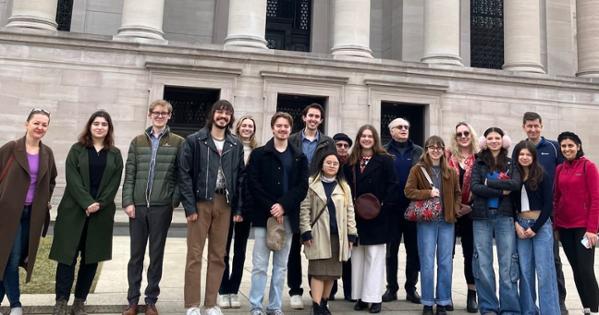University Students and Friends See Former Hermitage Treasures at the National Gallery of Art

On Saturday, March 2, 2024, The Carmel Institute organized a trip to the National Gallery of Art. Professor Fedyashin gave the students and several members of faculty a 90-minute tour of the paintings acquired by Andrew Mellon from the Hermitage Museum in 1930-31. Of the twenty-one paintings that Mellon purchased, fifteen are currently on display.
Museum visits, concert attendance, and class-trips have been part of the Carmel Institute’s programming since its inception. As Professor Fedyashin has always reminded his students, although our knowledge about the past depends primarily on reading, history must also be walked, seen, touched, smelled, and tasted.
The tour combined the biographies of the artists, the history of Western art, and the story of the paintings’ acquisitions. Given the Gallery’s current logistical reorganization, only the Dutch masters were on view. The group explored Fran Hals’s, Portrait of a Member of the Haarlem Civic Guard (c. 1636/1638); Sir Anthony van Dyck’s Susanna Fourment and Her Daughter (1621), Isabella Brant (1621), and Lord Wharton (1632); Rembrandt’s Man in Oriental Costume (c. 1635), A Polish Nobleman (1637), A Woman Holding a Pink (1656), and Joseph Accused by Potiphar's Wife (1655); and finally Jean Siméon Chardin’s The House of Cards (c. 1737). Dr. Fedyashin told the students about each painting’s acquisition by the Romanovs. All the paintings explored during this trip were Catherine the Great’s purchases. The French philosopher Denis Diderot was the most prominent of her agents in Europe. He was directly involved in negotiating the purchase of Rembrandt’s paintings in the 1770s. Chardin’s quiet domestic scene was also his recommendation. The addition to the Winter Palace of the Hermitage building that Catherine commissioned not only reflected the new neoclassical architectural trend, but also pointed to another side of her character—her love for quiet spaces to read and seek shelter from the Imperial Court. Although not a masterpiece on the scale of the other seven paintings, Chardin’s canvas with its lone card player on a minimalist background reflected Catherine’s desire for quiet contemplation.
The trip was a visual component of a holistic experience that stays with students of history for much longer. After the tour, the group went to lunch. Engaging with the history of art on the page and in the museum helped to open young minds to the importance of art history as well as the great legacy of American philanthropy.
